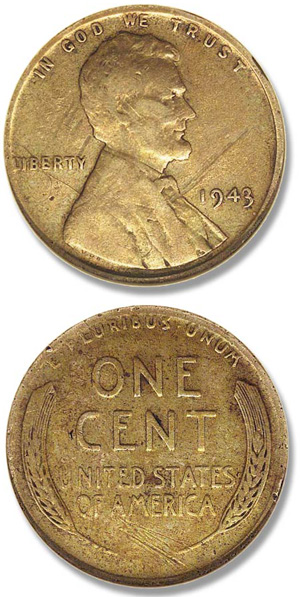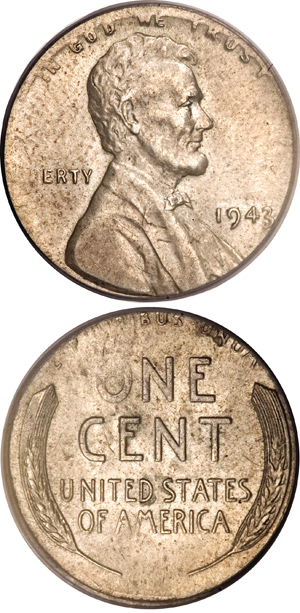|
"Making Cents"
Saturday, September 20, 2008
| P |
erhaps one of the more famous mint-error or variety coins of the 20th Century is the 1943 bronze cent.
In late 1942, the three mints were ordered to not produce any more bronze cents for 1943 but instead strike the 1943 coins on zinc-coated steel planchets. These wartime issues did not go over well, and before 1943 was over, the three mints were gearing up to resume the production of bronze cents – although many were made from recycled munitions casings which are also made of bronze.
The new shiny, steely coins were doomed to fail for these reasons: 1) They looked like dimes to some people, especially when mint-new; 2) They fouled up the chewing-gum vending machines because the coins are magnetic; and 3) After a few months, many of the coins started to rust, oxidize and corrode due to the reactivity of the zinc.
During 1943, apparently a few bronze planchets from the previous year got into the coinage stream and a few bronze 1943 cents were struck. Apparently the biggest number of errors escaped the Philadelphia Mint; nine P-mint 1943 bronze cents had been authenticated as of 1999.
The first one was reported to have been discovered by a school boy in his school cafeteria in 1947. It was eventually sold in 1958 for an astounding $40,000. At the time, it was the only one known. Between 1960 and 1992, another eight specimens were found and sold with prices ranging from $8,000 to $23,000.
The story of the 1943-S cents poses another question. That is, why were they not discovered before 1960? A possible answer to that mystery was presented by a David Reis of Redwood City, Calif. He wrote to the Society of Lincoln Cent Collectors in 2006 explaining that his father, at age 16, worked during the summer of 1943 at the San Francisco Mint.
Reis showed SLCC a copy of the worker's pass his father was issued. His father had told him that he found a group of bronze planchets while on the assembly line and tossed them into the production line. He went to the other end of the line and retrieved the freshly minted bronze cents. He took them home and kept them until 1960 when he gave them to his mother.
David asked his grandmother some years before his father passed away in 2006 if she knew where these coins were. She didn't recall. It was about 1960 when the first of the six known 1943-S bronze cents were discovered in circulation — all in the Bay Area of California — and graded from extra fine to about uncirculated, indicating they all got some use in circulation, but not many years' worth.
In the 1996 population data gathered by Steve Benson, they sold initially at prices from $9,000 (in 1973) to $50,000 (in 1983).
Finally one specimen of the 1943-D cent is known in bronze. This specimen traces its origins to a deliberately made coin probably by John R. Sinnock, chief engraver of the US Mint at the time – as it was later discovered in the estate of a woman Sinnock was dating in the 1940s, when both lived in the small town of North Tonawanda, N.Y.
This piece was eventually graded by Numismatic Guaranty Corporation as Mint State-64 Brown. The coin has tiny remnants of zinc, indicating it was struck from dies that had just been used to strike the normal 1943 zinc-steel cents.
The total population of 1943 bronze cents from all three mints is as follows: 12 or 13 from Philadelphia (one coin may have been certified twice); one from Denver and seven from San Francisco.* * *
Over the years, the 1943 bronze cent has generated all sorts of schemes, scams, and media hype.
Several newspaper and magazine ads of the 1940s and 1950s offered rewards from $3,000 to $10,000 for such a coin. Other ads promoted copper-plated zinc cents for prices such as 69 cents to "fool your friends," as one advertisement stated.
One rumor, never substantiated, claimed that Ford Motor Co. would give the finder a new car in exchange for a 1943 bronze cent. It never happened.
The survey of these coins was compiled by Steve Benson, who first published it in the third edition of "The Standard Guide to the Lincoln Cent." The survey, as updated, has appeared in more recent editions of Lincoln Cent books including my fourth edition, published in 1999. Some pieces have been sold more recently; at least one went for more than $100,000.
Perhaps not as valued as the famed 1913 Liberty head nickel, the 1943 bronze cent certainly ranks high up there among the last century's premiere mint varieties.
Interestingly, I discovered a rare (if not unique) 1943-S cent at a Superior auction at the American Numismatic Association convention in Anaheim in 1995. In a mixed lot of mint-error coins was a 1943-S cent with a clipped planchet. It was also slightly off center. That attracted my eye – but the color was silver, not zinc. I took my pocket magnet and voila: The coin was not magnetic – because it was SILVER. This was a 1943-S cent struck on a silver dime planchet!
The lot, sold for more than $200, since it contained several other off-center mint errors. Obviously, the cataloguer did not know the coin was silver. An off-center 1943-S cent with a clipped planchet might be worth $10 to $20. This coin sold for $500 in an SLCC Mail Bid Sale, and today it would bring ten times that amount or more at a major auction. It is featured in Flynn & Wexler's Lincoln cent book (P. 288).
Other 1943 cents are known on dime planchets and would bring $1,000 to $2,000 at auction, depending on the coin's condition.
The new shiny, steely coins were doomed to fail for these reasons: 1) They looked like dimes to some people, especially when mint-new; 2) They fouled up the chewing-gum vending machines because the coins are magnetic; and 3) After a few months, many of the coins started to rust, oxidize and corrode due to the reactivity of the zinc.
During 1943, apparently a few bronze planchets from the previous year got into the coinage stream and a few bronze 1943 cents were struck. Apparently the biggest number of errors escaped the Philadelphia Mint; nine P-mint 1943 bronze cents had been authenticated as of 1999.
The first one was reported to have been discovered by a school boy in his school cafeteria in 1947. It was eventually sold in 1958 for an astounding $40,000. At the time, it was the only one known. Between 1960 and 1992, another eight specimens were found and sold with prices ranging from $8,000 to $23,000.
The story of the 1943-S cents poses another question. That is, why were they not discovered before 1960? A possible answer to that mystery was presented by a David Reis of Redwood City, Calif. He wrote to the Society of Lincoln Cent Collectors in 2006 explaining that his father, at age 16, worked during the summer of 1943 at the San Francisco Mint.
Reis showed SLCC a copy of the worker's pass his father was issued. His father had told him that he found a group of bronze planchets while on the assembly line and tossed them into the production line. He went to the other end of the line and retrieved the freshly minted bronze cents. He took them home and kept them until 1960 when he gave them to his mother.
David asked his grandmother some years before his father passed away in 2006 if she knew where these coins were. She didn't recall. It was about 1960 when the first of the six known 1943-S bronze cents were discovered in circulation — all in the Bay Area of California — and graded from extra fine to about uncirculated, indicating they all got some use in circulation, but not many years' worth.
In the 1996 population data gathered by Steve Benson, they sold initially at prices from $9,000 (in 1973) to $50,000 (in 1983).
Finally one specimen of the 1943-D cent is known in bronze. This specimen traces its origins to a deliberately made coin probably by John R. Sinnock, chief engraver of the US Mint at the time – as it was later discovered in the estate of a woman Sinnock was dating in the 1940s, when both lived in the small town of North Tonawanda, N.Y.
This piece was eventually graded by Numismatic Guaranty Corporation as Mint State-64 Brown. The coin has tiny remnants of zinc, indicating it was struck from dies that had just been used to strike the normal 1943 zinc-steel cents.
The total population of 1943 bronze cents from all three mints is as follows: 12 or 13 from Philadelphia (one coin may have been certified twice); one from Denver and seven from San Francisco.
Over the years, the 1943 bronze cent has generated all sorts of schemes, scams, and media hype.
Several newspaper and magazine ads of the 1940s and 1950s offered rewards from $3,000 to $10,000 for such a coin. Other ads promoted copper-plated zinc cents for prices such as 69 cents to "fool your friends," as one advertisement stated.
One rumor, never substantiated, claimed that Ford Motor Co. would give the finder a new car in exchange for a 1943 bronze cent. It never happened.
The survey of these coins was compiled by Steve Benson, who first published it in the third edition of "The Standard Guide to the Lincoln Cent." The survey, as updated, has appeared in more recent editions of Lincoln Cent books including my fourth edition, published in 1999. Some pieces have been sold more recently; at least one went for more than $100,000.
Perhaps not as valued as the famed 1913 Liberty head nickel, the 1943 bronze cent certainly ranks high up there among the last century's premiere mint varieties.
Interestingly, I discovered a rare (if not unique) 1943-S cent at a Superior auction at the American Numismatic Association convention in Anaheim in 1995. In a mixed lot of mint-error coins was a 1943-S cent with a clipped planchet. It was also slightly off center. That attracted my eye – but the color was silver, not zinc. I took my pocket magnet and voila: The coin was not magnetic – because it was SILVER. This was a 1943-S cent struck on a silver dime planchet!
The lot, sold for more than $200, since it contained several other off-center mint errors. Obviously, the cataloguer did not know the coin was silver. An off-center 1943-S cent with a clipped planchet might be worth $10 to $20. This coin sold for $500 in an SLCC Mail Bid Sale, and today it would bring ten times that amount or more at a major auction. It is featured in Flynn & Wexler's Lincoln cent book (P. 288).
Other 1943 cents are known on dime planchets and would bring $1,000 to $2,000 at auction, depending on the coin's condition.
©2008 SCV COMMUNICATIONS GROUP & SOL TAYLOR · ALL RIGHTS RESERVED.

![[Most Recent Quotes from www.kitco.com]](http://www.kitconet.com/images/quotes_special.gif)


